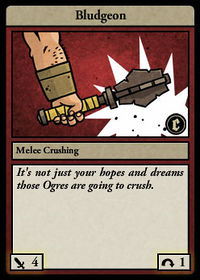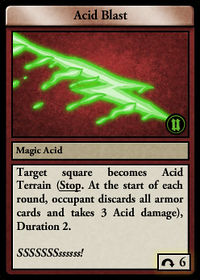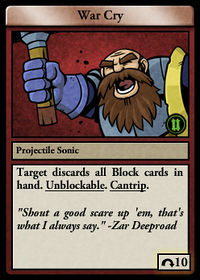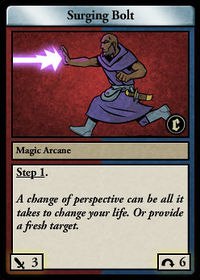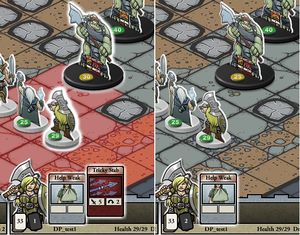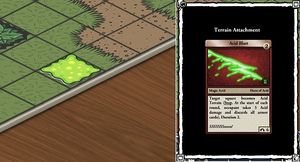Combat
| Line 40: | Line 40: | ||
To use an attack card, simply left click the card. If there are no targets in range, a prompt "There are no valid targets" will show. If there is only one target in range, the character will automatically attack the target. If there are multiple targets in range, the player has to select the desired target. To attack an ally character, '''Ctrl-click''' on the card and select the target. To modify the terrain, left click the card and select a tile in range. Figures below show some examples of attacking an enemy, attacking an ally and modifying the terrain. | To use an attack card, simply left click the card. If there are no targets in range, a prompt "There are no valid targets" will show. If there is only one target in range, the character will automatically attack the target. If there are multiple targets in range, the player has to select the desired target. To attack an ally character, '''Ctrl-click''' on the card and select the target. To modify the terrain, left click the card and select a tile in range. Figures below show some examples of attacking an enemy, attacking an ally and modifying the terrain. | ||
| − | {| | + | {| style="margin-left: auto; margin-right: auto;" |
| [[File:Attack1.jpg|thumb|300px|Fig. 5: Dwarven priest attacking a single target in range]] | | [[File:Attack1.jpg|thumb|300px|Fig. 5: Dwarven priest attacking a single target in range]] | ||
| [[File:Attack2.jpg|thumb|300px|Fig. 6: Dwarven wizard casts Wall of Fire under an Ogre Bruiser]] | | [[File:Attack2.jpg|thumb|300px|Fig. 6: Dwarven wizard casts Wall of Fire under an Ogre Bruiser]] | ||
Revision as of 22:52, 6 June 2013
Combat in Card Hunter is largely straightforward a la traditional dnd. A combat sequence generally consists of an attack from an instigator, a block roll and/or an armor roll from the target. There are multiple attack types and damage types, as well as multiple types of blocks and armors. This guide presents some basics with regard to combat and commonly encountered keywords associated with attack, block and armor cards. Readers are advised to browse the Card Types and Keywords guides for detailed information.
Contents |
Attack
An attack comprises of a damage payload and a delivery mechanism. The damage payload is described by two components: a damage type and/or a damage value/effect. The delivery mechanism refers to the way in which the payload is transferred, described by an attack type and a range. In Card Hunter, an attack does not necessarily need to have an attack range or a damage value. A global attack that targets all units in the board has no attack range. An attack that forcibly removes a target's cards from hand has no damage. In short, an attack consists of four components:
- Attack range (optional)
- Attack type
- Damage type
- Damage value (optional)
Due to the huge variety of attack and damage type combinations, there is a massive pool of attack cards available in game. In general, attack cards come in one of four classifications dependent on the objective of the attack:
- Attacking a target's hp
- Attacking a target's hand (forced discards, removals etc.)
- Attacking a target's terrain (obstacles, crowd control etc.)
- Attacking a target's state (movement, ability to play cards etc.)
| Figure 1 shows a staple card: Bludgeon. Bludgeon is a fairly common attack card found in most weapons. It is of melee attack type with a range of 1. Unmitigated, Bludgeon deals 4 crushing damage to a target. The attack type and damage type of a card are found in the card's information bar. The damage value is found beside the lower left sword symbol icon. The attack range is represented by a number beside the circular arrow symbol found in the lower right. Bludgeon is a very straightforward attack. It has no special keywords associated with it and does not carry other complicated instructions. Compare Bludgeon against Acid Blast (Fig. 2) which is a different attack card. Acid Blast is of magic attack type with a range of 6. It deals acid damage type with no damage value. Card instructions indicate that Acid Blast modifies a target square into acid terrain which comes with a set of complicated effects and a duration. Clearly, Acid Blast is unlike Bludgeon. Where Bludgeon deals melee damage to a target at close range instantly, Acid Blast does not deal any damage. Instead, it modifies a terrain tile with a terrain attachment (see below), impedes movement and debuffs any character standing on the terrain at the start of turn. Bludgeon is a simple example of an attack that against a target's hp only. While Acid Blast is a complex example of a attack that targets the terrain, opponent's hand, state and hp. However, Acid Blast is not an easy card to use while Bludgeon is a no-brainer. |
| Figure 3 shows a special attack card. Just like Acid Blast, War Cry does not contain a damage value. It is a projectile attack dealing sonic damage type up to a range of 10. War Cry is specifically designed to punish a target's hand by removing all in-hand blocks. This is especially useful against campaign minions like kobold warriors, goblin grunts and goblin shredders. Unlike Acid Blast, War Cry behaves as an instant attack, requiring no prior setup. However, War Cry fails in the case where the target's hand doesn't contain block cards. A certain amount of finesse and gameplay awareness is therefore required. Surging Bolt (Fig. 4) is an example of a hybrid attack card, denoted by its two color background. It contains a special keyword, Step 1 that allows the instigator to move up to 1 square from its original position before delivering a magic attack at range 6, causing 3 arcane damage to target. Hybrid cards are highly popular in high level game plays. Each hybrid card has dual use, this expands the strategic choices available. 5 hybrid cards are equivalent to 10 cards in hand. Hybrid cards are not without their drawbacks, this is especially true for hybrid attack cards. Using Surging Bolt as an example, the player can choose not to move during the Step phase. But the player MUST attack a target in range after, even if the only target in range is an ally. Therefore, be extremely cautious when using hybrid attack cards. |
Using attack cards
To use an attack card, simply left click the card. If there are no targets in range, a prompt "There are no valid targets" will show. If there is only one target in range, the character will automatically attack the target. If there are multiple targets in range, the player has to select the desired target. To attack an ally character, Ctrl-click on the card and select the target. To modify the terrain, left click the card and select a tile in range. Figures below show some examples of attacking an enemy, attacking an ally and modifying the terrain.
Attachments
An attack can leave two types of attachments: a terrain attachment (see Acid Blast above) or a character attachment.
| Figure 5 shows a terrain attachment after Acid Blast is cast on a target square. You can right-click on the terrain to bring up the information about the attachment card. A duration counter at the top right corner is as shown in the image. This counter indicates how many rounds the attachment will stay on the character before being discarded. A terrain attachment can be over written by another. For example, a wizard can cast Wall of Fire over the Acid Blast terrain. This changes the terrain attachment and the conditions of the said terrain will be updated accordingly. Just like terrains, characters (enemies, allies included) are also susceptible to attachments. Figure 6 shows a War Monkey after being attacked by Bad Luck. Like War Cry, Bad Luck does not damage the target. Instead, it reduces all die rolls of the target character by 1 for as long as the attachment persists. |
Attachments are not exclusive to attacks only. Assist cards provide beneficial card attachments that buff a character. Boost cards temporarily attach to a character to enhance its actions/reactions. Character attachments have to obey one golden rule. Each character can only have a maximum of three attachments at any one time. Character attachments obey the FIFO rule. The first attachment is removed when the same character experiences a fourth attachment. The second attachment is removed when the same character experiences a fifth attachment and so on and forth.
Tips:
- Holding down the Ctrl key while you left click a card allows you to target your own figures.
- A new terrain attachment will replace an existing one.
- If an attachment card is used on a character that already has three attachments, it will replace the oldest one.
- You can right-click on a square to check what kind of terrain it contains.
- An enemy with no move cards can't escape a terrain attachment!
Block
There are two explicit ways of mitigating an attack. If an attack is dealt to a target face-on, ie, the attacker and the target are facing each other when the attack is made, the target (holding block cards in hand) can block the attack. This negates the damage completely. Unlike attacks, blocks are not played. Instead, they only trigger when enemies play cards targeting you.
Armor
Coming Soon
